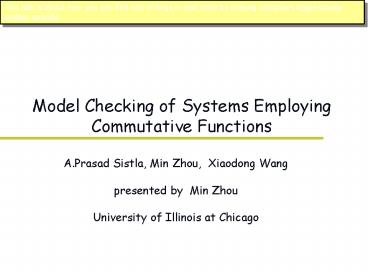Model Checking of Systems Employing Commutative Functions - PowerPoint PPT Presentation
Title:
Model Checking of Systems Employing Commutative Functions
Description:
... (TD) and Symbolic State Graph. Predicate Template and bisimulation ~0 ... an implicit universal quantifier over the free variables. p: x1 c. s.exp(x1): x1 1 ... – PowerPoint PPT presentation
Number of Views:32
Avg rating:3.0/5.0
Title: Model Checking of Systems Employing Commutative Functions
1
Model Checking of Systems Employing Commutative
Functions
This talk is about how you can find lots of bugs
in real code by making compilers aggressively
system specific
- A.Prasad Sistla, Min Zhou, Xiaodong Wang
- presented by Min Zhou
- University of Illinois at Chicago
2
Outline
- Transition Diagram(TD) and Symbolic State Graph
- Predicate Template and bisimulation 0
- Extended Predicate Template and bisimulation k
- Experiment Results
- Conclusion
3
Transition Diagram(TD)
- We only consider such TDs who only have
assignments - xc
- c is a constant
- xy
- y is another variable
- xf(x)
- f is a unary function
- each such f in a TD is commutative with each
other - f1? f2 f2 ? f1
ay ?y
1
ax,x
0
bx,x
2
by ?x0,y0
Variablesa,b,x,y
4
Symbolic State Graph
- Sym_Reach(G, u) (S0,R0, L0)
s.lc
s.val
s.exp
location
variables ? expressions s.exp(x) the
composition of functions that were applied to x
since last time a constant was assigned
variables ? values s.val(x) the latest constant
assigned to variable x
5
How to construct Symbolic State Graph
- TD
6
Symbolic States
- act_state(s) (s.lc, h) where h(x)
s.exp(x)s.val(x)
Symbolic States
actual states
?
?
?
?
?
7
Symbolic State Graph
val
TD
lc
exp
8
Our Goal
- Define a bisimulation relation over symbolic
states - For every location q, define a predicate
template ptemplates(q) - s 0 t require they are equivalent w.r.t
ptemplates(s.lc)
9
Predicate Template
var(p) ?X???
predicate, derived from guards and correctness
formula
10
What should be in ptemplates(q)
- (AP,fid) U (guard(q), fid ) ? ptemplates(q)
x f1(x)
xf2(x)
(P, fid) ? ptemplates(q)
p(x)
q1
q
qi
xf(x)
(P,f(x) y) ? ptemplates(q)
(P, f(x) ?) ? ptemplates(q)
11
Example
- p0 x ? y
- p1 a ? y
- p2 b ? y
- Formula ??(x ? y )
- Ptemplates(1)
- (p0, fid),
- (p1, fid),
- (p1, a ? x),
- (p2, b ? x)
12
Bisimulation 0
- Instantiate predicate templates in states
- (p(xi), xi ? yi) s p (s.exp (yi) /xi ) xi/
yi , where yi ? ? - Eg
- Define 0 as follows for any two states s and t,
s 0 t iff - s.lc t.lc, s.val t.val
- ?(p, f) ? ptemplates(s.lc), (p, f)s ? (p, f)t
- p x1 lt c
- s.exp(x1) x11
- s.exp(x2) x22
(p,x1 ? x2 ) s (s.exp (x2) lt c) x1/x2
(x12 lt c)
- an implicit universal quantifier over the free
variables
13
Theorem 1 0 is a bi-simulation on the
symbolic state graph Sym_Reach(G, u).
- Proof idea
- assume s0 0 t0 (p,fid) ? ptemplates(q1)
- In this case, (p,fid) ? ptemplates(q0)
- so we have (p,fid)s0 ? (p,fid)t0
14
Theorem 1 0 is a bi-simulation on the
symbolic state graph Sym_Reach(G, u).
- Now We show
- (p,fid)s1 ? (p,fid)t1
- (p,fid)s0 ? (p,fid)t0 ?
- ?x Ps0.exp(x) ? Pt0.exp(x) ?
- ?x Ps0.exp(f (x)) ? Pt0.exp(f (x))
- ?x Pf (s0.exp(x)) ? Pf (t0.exp(x)) ?
- ?x Ps1.exp(x) ? Pt1.exp(x)
By commutation
15
Extension of Bisimulation 0
- If (p,f) ? ptemplates(q), we require (p,f)s ?
(p,f) t even in above case. - Not necessary. Only need when this path is
feasible for these two states
TD
X
X
16
Bisimulation k
P(x)
si
si-k
s
feasible, length k
- Only in this case, we require (p,f)s ? (p,f)
t
17
k
- In k , we require a conditional equivalence
- Lemma k1 ? k,
- but k1 need more computation
18
Example of a TD for which 0 ? 1
- any two states of the form
- (q1,(0,0), (x1 c ? 0, x2 c ? 0))
- are bisimular w.r.t 1
19
Experiment Results
20
Circular Queue
21
Sliding Window
22
Conclusion and future work
- Defined a non decreasing chain of bisimulation
- Can be used in a class of infinite systems
- k can be checked on-the-fly
- Need investigate how to combine with static
analysis































